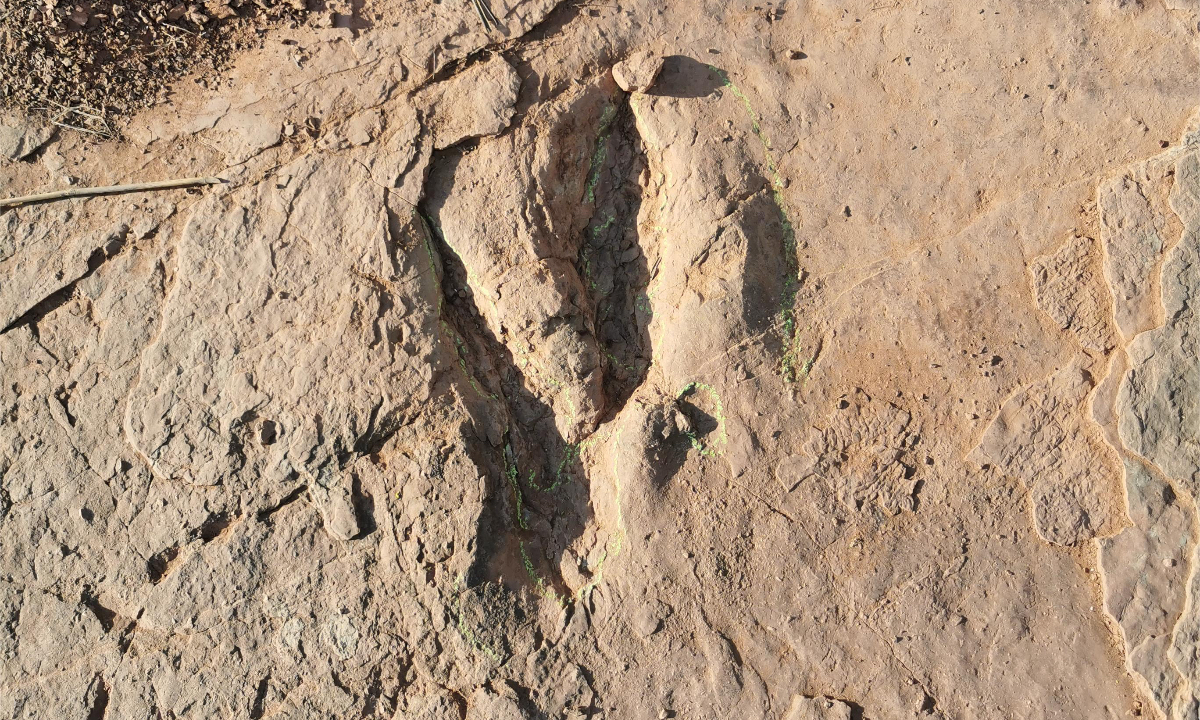
Photo: Courtesy of the Yingliang Stone Natural History Museum
On Monday morning, a team of scientists from the China University of Geosciences Beijing and the Yingliang Stone Natural History Museum announced the discovery of the largest known deinonychosaur footprints in the world at the Longxiang site in Longyan, East China's Fujian Province, establishing a new ichnospecies named Fujianipus yingliangi.
Deinonychosaurs were a group of carnivorous or omnivorous theropod dinosaurs that lived from the Late Jurassic to the Cretaceous period. Famous members of this group include velociraptor and
deinonychus, featured in the
Jurassic Park films.
The related paper, titled "Deinonychosaur trackways in southeastern China record a possible giant troodontid" was published in the academic journal iScience, a sub-journal of Cell, in April.
A total of 248 sets of well-preserved dinosaur tracks were found by a team of scientists in the mud flats in the Longyan prefecture in 2020. Among them, there were 12 footprints by two-toed deinonychosaurs, which can be clearly divided into two types based on size and morphology.
The smaller tracks, about 11 centimeters long, were identified as
Velociraptorichnus, a footprint belonging to a creature possibly similar to velociraptor. The larger tracks, about 36 centimeters long, establish the ichnotaxon Fujianipus yingliangi. Based on the size of the tracks, Fujianipus has an estimated length of at least 5 meters with a hip height of over 1.8 meters, putting it among the largest known raptors.
While many deinonychosaurs were small, the evolution of large deinonychosaurs was not uncommon and independently occurred multiple times. "The Fujianipus footprints represent another instance of independent gigantism in deinonychosaurs outside of the Americas," said Niu Kecheng, executive curator of the museum.
Deinonychosaurs were adorned with feathers. They had four claws on each foot. The first claw on each foot was small, and positioned away from the main foot. The second toe on the hind foot bore large sickle-shaped claws, which were typically raised upward during locomotion, leaving behind two-toed footprints made by the third and fourth toes on the ground.
According to Xing Lida, one of the authors of the paper, they found a total of six two-toe prints, with five prints forming a trackway. The average length of the footprints is about 36.4 centimeters, with a width of 16.9 centimeters.
These footprints, the largest deinonychosaur tracks found in China and even the world, highly likely belong to a large theropod dinosaur, possibly a type of large dromaeosaurid, Xing said.
For their research, the research team has established a new footprint classification. To pay tribute to the outstanding contributions of the Yingliang Stone Natural History Museum to dinosaur research in Fujian, they named this type of footprint Fujianipus yingliangi.
The formal naming of the Longxiang dinosaur footprint group in Fujian provides it with a true "scientific identity" as the best-preserved, largest, and most diverse Late Cretaceous dinosaur footprint group discovered in China to date, noted Niu.
The discovery also demonstrates the immense research potential of the Longxiang dinosaur footprint group in Fujian and is of great significance for the study of Late Cretaceous dinosaur fauna in China, Niu added.
Global Times
URL: https://www.seeglobalnews.com/read-3579.html